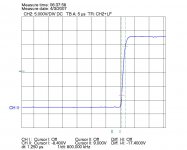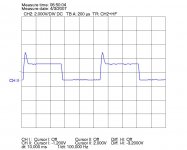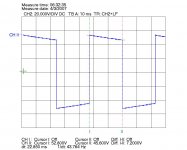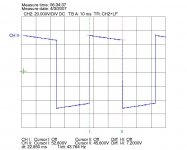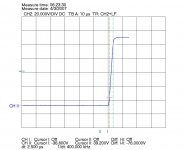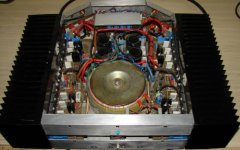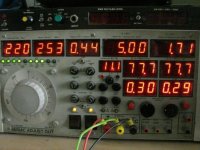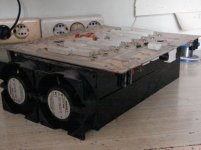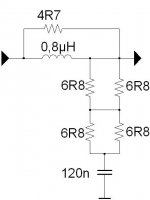Hi fotios,
Nothing you have written touches upon 'audio reproduction'.
You can have excellent simulation, fast square rise, flat square top and yet not have good sound.
You can make the slightest of changes to improve any of these aspects and yet degrade reproduction.
You show us this/that, but what does it sound like and have you compared it with others ?
Nothing you have written touches upon 'audio reproduction'.
You can have excellent simulation, fast square rise, flat square top and yet not have good sound.
You can make the slightest of changes to improve any of these aspects and yet degrade reproduction.
You show us this/that, but what does it sound like and have you compared it with others ?
peranders said:Ok, where were we? About the preamp module...
Sadly, doesn't seem we'll get there in a hurry. At the moment the topic is
real components with manhood
Graham Maynard said:Hi fotios,
Nothing you have written touches upon 'audio reproduction'.
You can have excellent simulation, fast square rise, flat square top and yet not have good sound.
You can make the slightest of changes to improve any of these aspects and yet degrade reproduction.
You show us this/that, but what does it sound like and have you compared it with others ?
The oscilograms are measured in real time and in a real component with real instruments. There is not any SIMULATION of the amplifier presented. Moreover this is evident for anyone who knows to read the charts of oscilograms. If you don't believe me, please make a question in HAMEG INSTRUMENTS DE. to confirm you that the graphs are true. In the top of each graph you can see marked the date and the time of measurement. There is no way to theft - at least - this instrument of HAMEG. Moreover there is any reason to do something like this?
Sincerelly
Fotios
Hello Fotios,
I am glad you are back! Let's try to keep this on topic and not personal.
Rather than replying to each and every post of you, let me say this. I think the confusion is not really there.
In many of these new curves you show high level output voltages (like up to 80V pk-pk if I am not mistaken) that show a rise time of a few uSec. That is a respectable slew rate of 30 to 40 V/uSec. It is not spectecularly high, but I am of the opinion that 1V/uSec per volts of output is more than adequate for audio, so I have no criticism on that.
What you initially showed was low level output like a few volts. That is the small signal value and you can have an amp that performs well at low level but then soon runs out of (internal charge) current with higher voltages. To judge slew rate you really need to look at max output level. Therefore my initial criticism.
Looking to the other posts that show your dirty harry and test equipment I can understand that you are quite experienced in building this type of equipment. Maybe you should give us some more info like circuits - but be prepared that there will comments and people not agreeing at all with your choices! That's the way it is here, you need a thick skin and trust in your own judgement and choices! Once you open your mind, you can learn a lot here!
Have a nice sunday,
Jan Didden
I am glad you are back! Let's try to keep this on topic and not personal.
Rather than replying to each and every post of you, let me say this. I think the confusion is not really there.
In many of these new curves you show high level output voltages (like up to 80V pk-pk if I am not mistaken) that show a rise time of a few uSec. That is a respectable slew rate of 30 to 40 V/uSec. It is not spectecularly high, but I am of the opinion that 1V/uSec per volts of output is more than adequate for audio, so I have no criticism on that.
What you initially showed was low level output like a few volts. That is the small signal value and you can have an amp that performs well at low level but then soon runs out of (internal charge) current with higher voltages. To judge slew rate you really need to look at max output level. Therefore my initial criticism.
Looking to the other posts that show your dirty harry and test equipment I can understand that you are quite experienced in building this type of equipment. Maybe you should give us some more info like circuits - but be prepared that there will comments and people not agreeing at all with your choices! That's the way it is here, you need a thick skin and trust in your own judgement and choices! Once you open your mind, you can learn a lot here!
Have a nice sunday,
Jan Didden
fotios said:
The oscilograms are measured in real time and in a real component with real instruments. There is not any SIMULATION of the amplifier presented. Moreover this is evident for anyone who knows to read the charts of oscilograms. If you don't believe me, please make a question in HAMEG INSTRUMENTS DE. to confirm you that the graphs are true. In the top of each graph you can see marked the date and the time of measurement. There is no way to theft - at least - this instrument of HAMEG. Moreover there is any reason to do something like this?
Sincerelly
Fotios
Fotios try to read what he wrote! He didn't say your scope pictures are not real! He said that the curves don't tell how it sounds. And in that he is right.
Jan Didden
Hi Fotios,
re post62 oscillogram, 2uF//8r0 load.
What is the Thiel network on the output? it cannot be a Zobel since you mention "the DAMPING of output inductor".
All,
Why is the overshoot only in the positive direction?
How has the output inductor ringing been eliminated?
re post62 oscillogram, 2uF//8r0 load.
What is the Thiel network on the output? it cannot be a Zobel since you mention "the DAMPING of output inductor".
All,
Why is the overshoot only in the positive direction?
How has the output inductor ringing been eliminated?
Hi,
the new results seem to have given an answer to my earlier question.
Output voltage level makes an enormous difference to measured Slew Rate at the output.
It appears that if the unit is not giving an output near maximum level, then any slew rate measurements are useless.
the new results seem to have given an answer to my earlier question.
Output voltage level makes an enormous difference to measured Slew Rate at the output.
It appears that if the unit is not giving an output near maximum level, then any slew rate measurements are useless.
AndrewT said:Hi,
the new results seem to have given an answer to my earlier question.
Output voltage level makes an enormous difference to measured Slew Rate at the output.
It appears that if the unit is not giving an output near maximum level, then any slew rate measurements are useless.
Actually the slew rate is even larger than we think, because the amp doesn't show slew rate limiting even with max output. It shows a nice exponential rise time. This amp is faster than it looks.
Jan Didden
Because the output inductor moved - this is an unusual practice of course - internally of zobel network as you can see in the picture attachedAndrewT said:Hi Fotios,
re post62 oscillogram, 2uF//8r0 load.
What is the Thiel network on the output? it cannot be a Zobel since you mention "the DAMPING of output inductor".
All,
Why is the overshoot only in the positive direction?
How has the output inductor ringing been eliminated?
Attachments
- Status
- This old topic is closed. If you want to reopen this topic, contact a moderator using the "Report Post" button.
- Home
- Amplifiers
- Solid State
- Wow!!! A wonderful preamplifier module!
